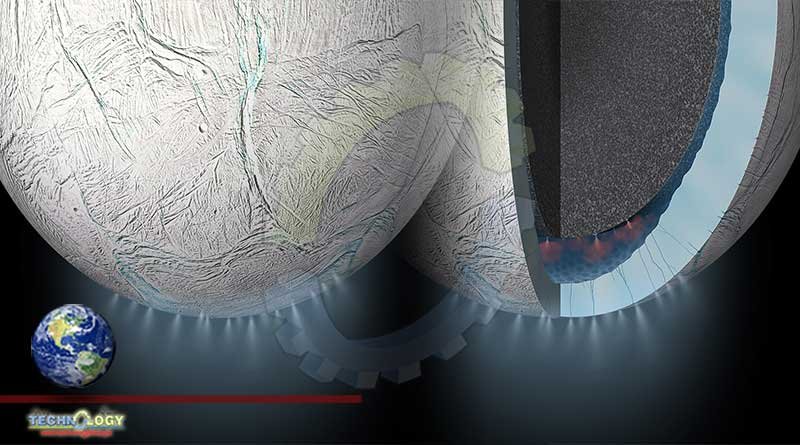Saturn’s moon Enceladus has ‘churning’ ocean currents buried beneath its its shiny surface of 12 miles of ice, according to a new study.

Saturn’s moon Enceladus has ‘churning’ ocean currents buried beneath its 12 miles of ice, according to a new study.
It’s already known that Enceladus – one of Saturn’s 82 moons – hides water beneath its shiny, icy surface.
But experts at California Institute of Technology (Caltech) think ocean currents are flowing on Enceladus a bit like those near Antarctica, driven by salty water.
They’ve based their estimations on computer modelling that used data gathered by NASA’s no-longer-operational Cassini spacecraft.
Enceladus is one of few locations in the Solar System with liquid water, along with Earth and Jupiter’s moon Europa, making it a target of interest for astrobiologists.
The new research could inform scientists where to one day search for signs of life on Enceladus during future satellite missions, according to Caltech.
‘Understanding which regions of the subsurface ocean might be the most hospitable to life as we know it could one day inform efforts to search for signs of life,’ said study author Andrew Thompson, professor of environmental science and engineering at Caltech.
Enceladus – Saturn’s sixth-largest moon out of its 82 in total – is a frozen sphere just 313 miles in diameter (about one-seventh the diameter of Earth’s moon).
Enceladus is covered in a shimmering layer of clean ice, making it one of the most reflective bodies in the Solar System.
Despite its relatively small size, Enceladus attracted the attention of scientists in 2014 thanks to data from Cassini.
At the time, the plucky spacecraft discovered evidence of its large subsurface ocean and sampled water from geyser-like eruptions that occur through fissures in the ice at its south pole.
Jets of water and some solid particles such as ice crystal spout from fractures in the frozen surface called ‘tiger stripes’.
Despite the fact Earth and Enceladus harbour water, the ocean on Enceladus is almost entirely unlike Earth’s.
Earth’s ocean is relatively shallow, with an average of 2.2 miles (3.6 km), and covers three-quarters of the planet’s surface.
Our ocean is also warmer at the top thanks to the Sun’s rays and colder in the depths near the seafloor, and has currents that are affected by wind.
Enceladus, meanwhile, appears to have a completely subsurface ocean at least 18.6 miles (30 km) deep, which goes all the way round the moon.
Enceladus’ ocean is cooled at the top near the ice shell and warmed at the bottom by heat from the moon’s core.
Despite their differences, the oceans of Enceladus and Earth share one important characteristic – they are salty.
Variations in salinity could serve as drivers of the ocean circulation on Enceladus, much as they do in Earth’s Southern Ocean, which surrounds Antarctica.
Gravitational measurements and heat calculations from Cassini had already revealed that Enceladus’ ice shell is thinner at the poles than at the equator.
Unsurprisingly, regions of thin ice at the poles are likely associated with melting, while regions of thick ice at the equator are associated with freezing, Thompson said.
But this affects the ocean currents, because when salty water freezes, it releases the salts and makes the surrounding water heavier, causing it to sink.
The complete opposite happens in regions of thin ice at the poles associated with melting.
A computer model, based on Thompson’s studies of Antarctica, suggests that the regions of freezing and melting, identified by the ice structure, would be connected by the ocean currents.
This would create a pole-to-equator circulation, almost like a conveyor belt, that influences the distribution of heat and nutrients.
The theory challenges current thinking that Enceladus’ global ocean is homogeneous apart from some vertical mixing driven by the warmth of its core.
‘Knowing the distribution of ice allows us to place constraints on circulation patterns,’ said Caltech graduate student Ana Lobo.
‘An idealised computer model, based on Thompson’s studies of Antarctica, suggests that the regions of freezing and melting, identified by the ice structure, would be connected by the ocean currents.
‘This would create a pole-to-equator circulation that influences the distribution of heat and nutrients.’
Scientists are still reaping the rewards of the rich data obtained by the Cassini robotic spacecraft, which was active for nearly 20 years after launching in October 1997.
Cassini’s mission ended in September 2017 when it was deliberately flown into Saturn’s upper atmosphere before it ran out of fuel.
In 2019, Cassini data revealed that a lake on Saturn’s largest moon, Titan, is rich with methane and 300 feet deep.
Another 20 new moons were confirmed orbiting the planet in 2019, making it ‘moon king’ of the solar system, beating Jupiter’s total of 79.
The new study has been published in Nature Geoscience.
Originally published at Brink wire
